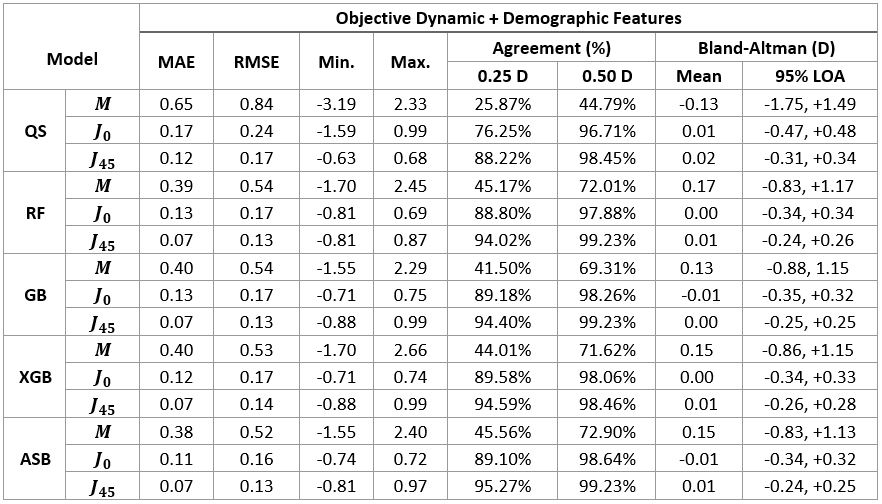Assessment of a machine learning approach to predict subjective sphero-cylindrical correction using wavefront aberrometry data

| AUTHORS | |
| JOURNAL | ARVO |
| ABSTRACT |
PurposeUncorrected Refractive Errors (UREs) is a reversible condition that can be treated with appropriate eyeglasses. UREs affect over 1 billion people globally, with 90% of this population living in low-and-middle-income countries where vision exams can be highly inaccessible due to a shortage of experienced eyecare professionals. This work aims to assess if a machine learning (ML) approach, when applied to data obtained with an affordable handheld autorefractor, could increase access to clinical-quality subjective refraction (SR) when operated by non-experts. MethodsData used for this analysis was obtained from a clinical study performed at Aravind Eye Hospital in Madurai, India, using a low-cost portable wavefront aberrometer, an early prototype of the QuickSee (QS) (PlenOptika, Inc., USA). A total of 669 participants were enrolled with ages ranging between 15 and 70 years (35.2 ± 13.7) and spherical equivalent error between -6.0 D and 3.5 D (-0.7 ± 1.67 D). Four ML regressor models were trained and tested for each power vector M, J0 and J45: random forest (RF), gradient boosting (GB), extreme gradient boosting (XGB), and a custom assembly model (ASB) that averages the predictions of RF, GB, and XGB. Algorithms were trained on a dataset of 1,244 samples using as input features: age, gender, Zernike coefficients up to 5th order, and measurement quality related metrics provided by the autorefractor. A smaller subset of 518 unseen samples was used to test the agreement of the predictions against SR using Bland-Altman analysis, overall prediction error in terms of mean absolute error (MAE) and root mean squared error (RMSE), and the percentage of agreement for 0.25 D and 0.5 D thresholds. ResultsAll models improved the agreement with SR compared to the baseline autorefraction, but ASB obtained the best results (Table 1). Bland-Altman analysis showed a decrease in the 95% limits of agreement of ±0.63 D, ±0.14 D, and ±0.08 D for M, J0 and J45, respectively. The wavefront-aberrometry related variables had the biggest impact on the prediction, while demographic and measurement quality-related features showed a heterogeneous but consistent predictive value. ConclusionsThese results suggest that ML is effective for improving precision in predicting patient’s SR from objective measurements taken with a low-cost portable device. |
| LINK | here |



